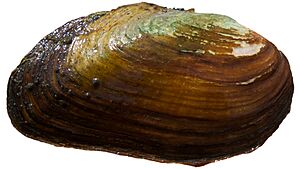Eastern elliptio facts for kids
Quick facts for kids Eastern elliptio |
|
|---|---|
 |
|
| Conservation status | |
| Scientific classification | |
| Genus: |
Elliptio
|
| Species: |
complanata
|
| Synonyms | |
|
List
? complanata Lightfoot
Elliptio complanata subsp. complanata (Lightfoot) 1786 Elliptio complanatus (Lightfoot) 1786 Elliptio complanatus subsp. catawbensis (I.Lea, 1857) Elliptio complanatus subsp. complanatus (Lightfoot) 1786 Elliptio complanatus subsp. cuvierianus (I.Lea, 1853) Elliptio complanatus subsp. jejunus (I.Lea, 1838) Elliptio complanatus subsp. northamptonensis (I.Lea, 1862) Elliptio complanatus subsp. quadrilaterus (I.Lea, 1863) Elliptio complanatus subsp. subinflatus (Conrad, 1835) Elliptio errans (I.Lea, 1857) Elliptio geminus (I.Lea, 1856) Elliptio insulsus (I.Lea, 1857) Elliptio nubilus (I.Lea, 1868) Elliptio rostrum (I.Lea, 1862) Elliptio spadiceus (I.Lea, 1857) Elliptio subinflatus (Conrad, 1835) Elliptio violaceus (Spengler, 1793) Elliptio violaceus subsp. cuvierianus (I.Lea, 1853) Elliptio violaceus subsp. jejunus (I.Lea, 1838) Elliptio violaceus subsp. northamptonensis (I.Lea, 1862) Elliptio violaceus subsp. subinflatus (Conrad, 1835) Elliptio violaceus subsp. wheatleyi (I.Lea, 1857) Margarita (Unio) complanata (Lightfoot) 1786 Margarita (Unio) griffithianus (I.Lea, 1834) Margarita (Unio) paliatus I.Lea, 1836 Margaritana decumbens (I.Lea, 1861) Margaritifera decumbens (I.Lea, 1861) Margaritifera decumbens (I.Lea, 1861) Margaron (Unio) abbevillensis (I.Lea, 1857) Margaron (Unio) aberrans (I.Lea, 1863) Margaron (Unio) baldwinensis (I.Lea, 1859) Margaron (Unio) beaverensis (I.Lea, 1868) Margaron (Unio) burkensis (I.Lea, 1859) Margaron (Unio) catawbensis (I.Lea, 1857) Margaron (Unio) chathamensis (I.Lea, 1863) Margaron (Unio) complanatus (Lightfoot) 1786 Margaron (Unio) contractus (I.Lea, 1857) Margaron (Unio) curatus (I.Lea, 1863) Margaron (Unio) cuvierianus (I.Lea, 1853) Margaron (Unio) datus (I.Lea, 1868) Margaron (Unio) decumbens (I.Lea, 1861) Margaron (Unio) errans (I.Lea, 1857) Margaron (Unio) exactus (I.Lea, 1858) Margaron (Unio) fuliginosus (I.Lea, 1845) Margaron (Unio) gastonensis (I.Lea, 1863) Margaron (Unio) geminus (I.Lea, 1856) Margaron (Unio) griffithianus (I.Lea, 1834) Margaron (Unio) humerosus (I.Lea, 1868) Margaron (Unio) indefinitus (I.Lea, 1863) |
|
The eastern elliptio (Elliptio complanata) is a type of freshwater mussel. It belongs to the Unionidae family. These mussels are native to Canada and the United States. They are a kind of bivalve animal, part of the phylum Mollusca.
Eastern elliptios are often the most common mussel in the waterways where they live. For example, they are very common in the Delaware River. They are also the most common mussel found in New Hampshire and Vermont. You can find them living in the sand or mud at the bottom of lakes, ponds, and rivers. These mussels can grow up to about 13 centimeters (5 inches) long.
Reproduction
Eastern elliptios reproduce by spawning. This usually happens from the third week of April to the second week of June. During spawning, the mussels release their reproductive cells into the water.
Life cycle
Like many other freshwater mussels, the Elliptio complanata has an interesting life cycle. It starts as a tiny egg inside the female mussel's gills. The egg then grows into a larva called a glochidium.
These glochidia need to attach to a host fish to grow further. They cling to the fish's fins or gills. After a while, they change into a juvenile mussel. Then they drop off the fish and start living on their own in the water.
Some fish species that host the Elliptio complanata glochidia include:
- American eel (Anguilla rostrata)
- Brook trout (Salvelinus fontinalis)
- Lake trout (Salvelinus namaycush)
- Mottled sculpin (Cottus bairdii)
- Slimy sculpin (Cottus cognatus)
The American eel is the most successful host for these mussels. This means more glochidia survive and grow into young mussels when they attach to an American eel.


